9
Learning Objectives
- Identify the key geographic features of East and Southeast Asia
- Explain how East and Southeast Asia’s history has affected its geographic landscape
- Describe the patterns of economic development in East and Southeast Asia
- Analyze how East and Southeast Asia interacts within the global economic system
9.1 The Physical Landscape of East and Southeast Asia
East and Southeast Asia (see Figure 9.1) contains the world’s most populous country, the most populous metropolitan area, and some of the world’s oldest civilizations. It is also a region with intense internal disparities and a landscape that has been and continues to be transformed by physical, political, and economic forces. Although East and Southeast Asia are often divided into two regions, they share a common economic and political history and global geopolitical forces continue to transform this realm.
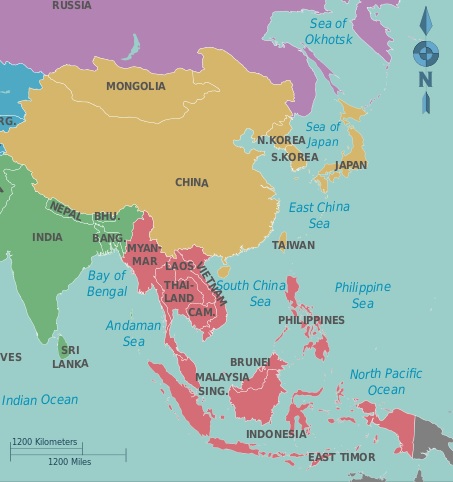
The region of East and Southeast Asia is divided from the rest of Asia by a number of formidable physical barriers (see Figure 9.2). In the north, Mongolia’s Altay Mountains, the Mongolian Plateau, and the Gobi Desert separate the region from Russia. In the south, the Himalaya Mountains divide China from South Asia and contain the world’s highest mountain, Mount Everest. These mountains are so high, in fact, that they form the Gobi Desert by preventing rainfall from passing over South Asia into Central Asia. In the southeast, the Arkan Mountains and Naga Hills, which stretch across Myanmar and India, and the rolling hills of China’s Yunnan Plateau separate Southeast Asia from the rest of the continent. In general, this is a realm of relatively high relief, meaning there are significant changes in elevation on the landscape. Even the islands of this region have a rugged topography, from Japan’s Mount Fuji to Indonesia’s Mount Carstensz.
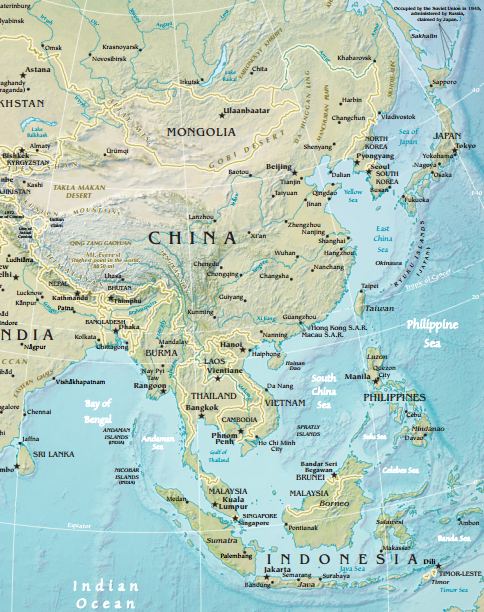
The rivers of this region have supported both ancient cultures and modern societies providing irrigation for agriculture, river transportation, and in some cases, hydropower. Asia’s longest river, the Yangtze, flows through central China; the economic activity surrounding its river valley generates around one-fifth of the entire country’s gross domestic product (GDP). In 2003, the Chinese government built the Three Gorges Dam, the world’s largest hydroelectric power station, which spans the river. China’s other major river, the Huang He River, also known as the Yellow River, flows through the highlands of Western China before discharging in Northeastern China. It was on the banks of the Huang He that Chinese civilization first began. In Southeast Asia, the region is dominated by the Mekong and Irrawaddy Rivers. The Mekong River, one of the most biodiverse rivers in the world, has been heavily dammed, impacting the area’s ecology, and plans are underway to dam the Irrawaddy in several places. In addition, both the Mekong and the Irrawaddy originate in China, presenting issues over river flow and ownership.
Although the construction of the region’s numerous dams has provided reliable power, they’ve been met with significant social and ecological impacts. The Three Gorges Dam, for example, was an unprecedented engineering marvel and will reduce the potential for downstream flooding, but flooding from the creation of the dam displaced over one million people and significantly reduced forest area around the river.
Most of the region’s people live in the more temperate climate zones. In East Asia, for example, the coastal regions of Central and Southern China, Japan, and South Korea are primarily a humid temperate climate. Southeast Asia is largely tropical with ample rainfall throughout the year. The exception to these relatively warm areas are Western China, where the cold highland climate dominates, and Northeastern Asia is quite cold due to its high northern latitude.
The region’s physical landscape has significantly affected its agricultural practices. The banks of East and Southeast Asia’s rivers provided early settlers with fertile soil, and even today, provide agricultural irrigation. The region’s hilly terrain, though initially an obstacle to agricultural productivity, inspired innovations such as terracing, cutting a series of flat surfaces resembling steps on hillsides. China in particular continues to be a global leader in terms of agricultural production.
9.2 Natural Hazards in East and Southeast Asia
Much of what unites this region is its instability, not necessarily in terms of geopolitics, but rather its physical landscape. East and Southeast Asia are located in the Pacific Ring of Fire, an area of high tectonic activity along the Pacific Ocean basin (see Figure 9.3). The vast majority of the world’s earthquakes, around 90 percent, occur along this geologically unstable area.
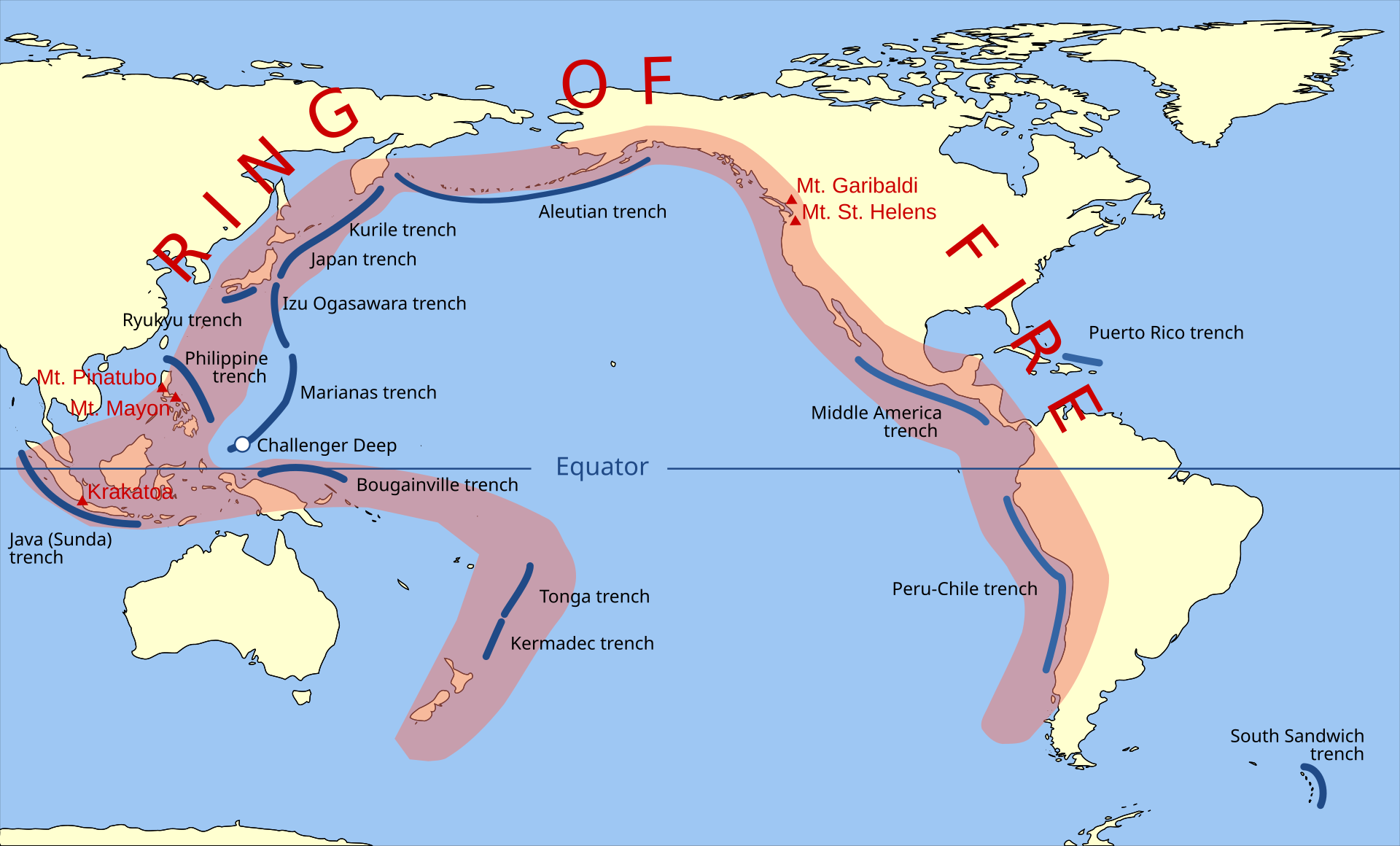
In East and Southeast Asia, tectonic collisions have shaped the physical landforms present in the region and present numerous natural hazards (see Figure 9.4). Volcanoes erupt in this region frequently, and many of the islands in this region were actually formed from a variety of historic volcanic eruptions. Japan’s highest mountain peak, for example, the majestic Mount Fuji, is an active volcano that last erupted in the early 18th century. The 1815 eruption of Indonesia’s Mount Tambora, one of its dozens of active volcanoes, was so powerful, it cooled global temperatures and caused crop failures as far away as Egypt and France. In 1883, the volcanic island of Krakatoa, between the Indonesian islands of Java and Sumatra, erupted with such a violent explosion that it actually collapsed. Tens of thousands died and it took several years for global weather patterns to return to normal. The sound of the eruption is considered the loudest sound in modern history and could be heard from over 4,800 kilometers (3,000 miles) away.
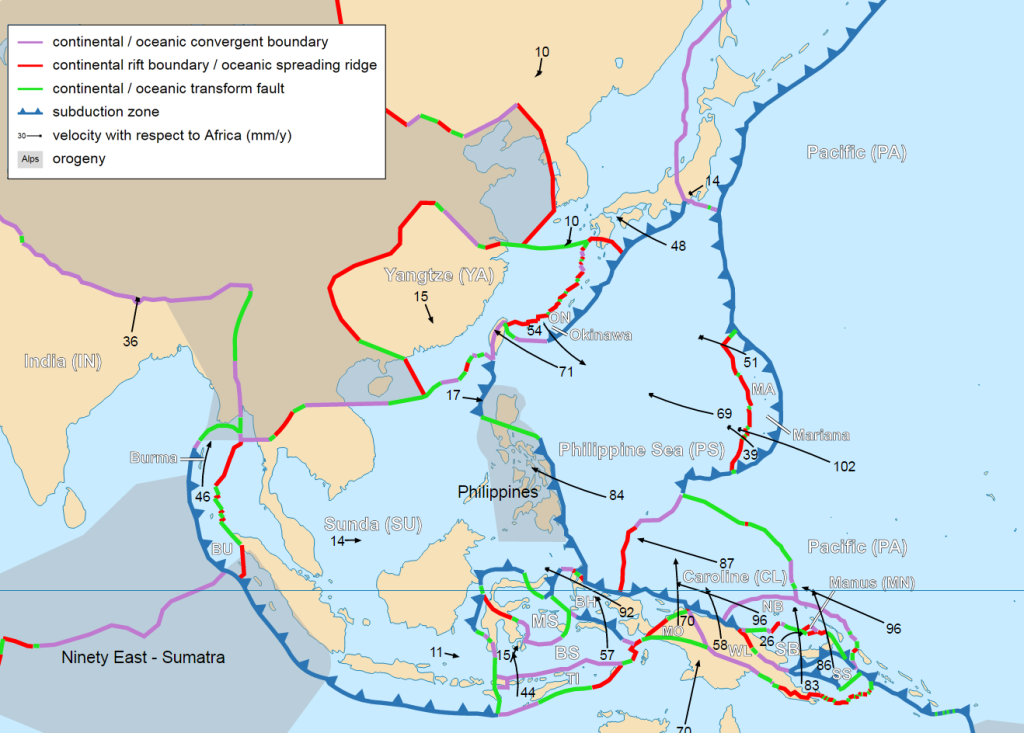
Along the islands of Indonesia, the Australian Plate is subducting, or moving below, the Eurasian Plate. This has resulted in a subduction zone west of the Indonesian island of Sumatra, an area of high seismic activity. In 2004, this subduction resulted in a massive undersea earthquake, so powerful that it actually shortened the day by a fraction of a second. The earthquake triggered a series of tsunamis, high sea waves, which devastated coastal communities in 14 different countries and killed 230,000 people. Tsunamis result from the displacement of water and can have a variety of causes, such as a landslide, meteor impact, or undersea volcanic eruption. Most commonly, though, they result from earthquakes.
In 2011, the most powerful earthquake to ever hit Japan, a magnitude 9.0, resulted in tsunami waves over 40 meters (131 feet) high in some areas. The earthquake and subsequent tsunami left over 15,000 dead and damaged hundreds of thousands of buildings. Most notably, the tsunami damaged Japan’s Fukushima Daiichi Nuclear Power Plant causing a series of nuclear meltdowns and the release of radioactive material.
So what can be done about the danger from earthquakes, volcanoes, and tsunamis in this region? While nothing can stop Earth’s massive tectonic plates from moving, warning systems, land use planning, and public education could help prevent casualties. After the 2004 Indonesian earthquake and tsunami, the international community created an Indian Ocean tsunami warning system. Although some of the hardest hit areas would have had only minutes to find higher ground, the warning system could have had a significant impact in alerting areas ahead of the wave. In Japan, earthquake drills are common and strict building codes ensure that buildings can withstand most seismic activity.
In addition to these geologic hazards, typhoons are also common in this region. Typhoons, the term for tropical cyclones in the northwestern region of the Pacific Ocean, routinely make landfall in East Asia. The region actually has more tropical cyclone activity than anywhere else on Earth. Most storms form in the summer between June and November and the islands of the Philippines are generally the hardest hit. Monitoring systems have been in place in the region for several decades and have helped to minimize the impacts from these powerful storm systems.
9.3 East and Southeast Asia’s History and Settlement
The history of human settlement in East and Southeast Asia begins in China. Evidence of modern humans can be found in the region dating back to over 80,000 years ago. Around 10,000 years ago, several cultural groups emerged in China during the Neolithic Period, also known as the New Stone Age. This was a time of key developments in early human technology, such as farming, the domestication of plants and animals, and the use of pottery. Along China’s Yangtze River, humans first domesticated rice around 6500 BCE. Villages, walled cities, and great dynasties, or families of rulers, emerged later.
While some early humans stayed in East Asia, others followed the coastline and continued on to Southeast Asia likely over 50,000 years ago. This was during the glacial period known as the Ice Age. Global temperatures were much colder and huge sheets of ice covered North America, Europe, and Asia. Since so much water was trapped
in these huge glaciers, ocean levels were actually much lower than they are today. Indonesia, Malaysia, and the other islands of Southeast Asia were a single landmass known as Sunda (see Figure 9.5). Those cultural groups who had seafaring knowledge continued on, populating Australia and the surrounding islands. During the Ice Age, the southern islands of Japan were also connected to the rest of Eurasia, allowing the indigenous groups of Japan to migrate from what is now mainland China.
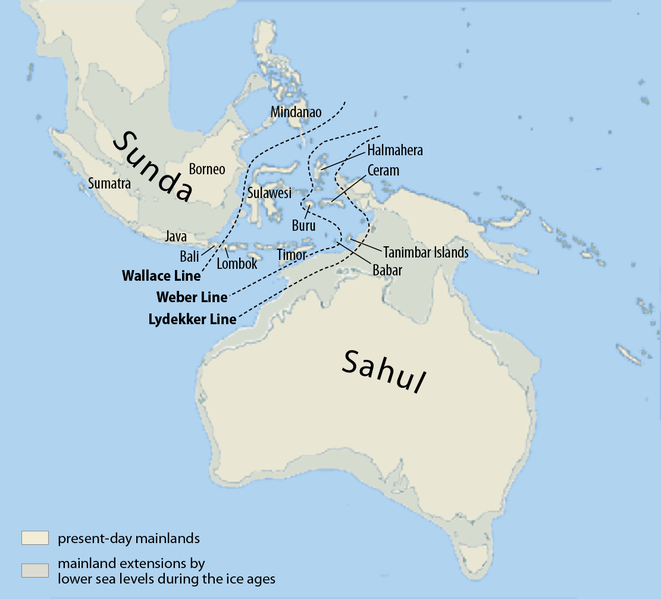
In East Asia, the Chinese dynasties dominated the political landscape for much of the region’s history. They established trade routes, a strong military, and forged connections with Korea and Japan. China became a unified state under the Han dynasty, which ruled from 206 BCE to 220 CE, and this long period of stability is viewed as
a golden age in Chinese history. The dominant ethnic group in China, the Han, take their name from this ruling family. It was also during this time that Confucianism became the state religion. Confucianism takes its name from the influential Chinese philosopher and teacher Kong Fuzi (551-479 BCE), often referred to by the Latinized version of his name, Confucius. One of Confucius’ key teachings was the importance of relationships, both within the family and within society as a whole and the religion emphasizes human goodness and self-reflection rather than the worship of a divine being. Confucius also emphasized education and his teachings have dominated Chinese culture for centuries.
In general, the Chinese dynasties were largely isolationist. China has a number of physical barriers that separate it from the rest of Asia, such as the Himalayas, the rugged western highlands, and the Gobi Desert. The only region where it was vulnerable to invasion was its northeastern region. Here, the ruling families of China built a series of walls, known today as simply the Great Wall of China (see Figure 9.6).

However, the term “the” Great Wall of China is a misnomer. In fact, there is a series of overlapping walled fortifications that began being constructed by early dynasties in the 5th century BCE and continued through to the 17th century CE. Walls are a defensive military structure and are thus an expression of a civilization that wished to be left alone. Emperors generally disregarded China’s extensive coastline, and where port cities did emerge, they were primarily used for local trade.
In Southeast Asia, however, trade links with South Asia brought Hinduism and later Buddhism to the region. Port cities emerged, as well as cities that were religious or ceremonial centers. The Hindu rulers of the region were often viewed as divine, but in order to secure the favor of the gods, and the blessings of the Hindu priests, they agreed to build temples. Angkor Wat, in Cambodia, for instance, was built in the 12th century as the king’s state temple and capital city (see Figure 9.7). It was later transformed into a Buddhist temple, which it remains today. The temple complex is the largest religious structure in the world.

Eventually, Islam spread to Southeast Asia, particularly as a result of Sufi missionaries, part of a mystical branch of Islam. In the present-day islands of Malaysia and Indonesia, in particular, local rulers and communities embraced Islamic theology. Today, more Muslims live in Indonesia than in any other country on Earth.
Buddhism continued to dominate the religious landscape of much of Southeast Asia as well as in Japan. During the Heian period, lasting from the late 8th centuries to the 12th century CE, many of the features of modern Japanese culture emerged, such as its distinctive art and poetry, as well as Buddhist-inspired architecture. A ruling class of warriors, known as a shogunate, would later take control of Japan beginning a feudal period in the country’s history.
The evolving landscape of this region would be completely transformed by colonization, with sweeping political and economic changes that continues to shape the geography of the region today. Beginning in the 16th century, European colonial empires became interested in Southeast Asia. Before long, Europeans established permanent colonies. The Spanish would settle the Philippines, the Netherlands established the Dutch East Indies in present-day Indonesia, the French created Indochina in mainland Southeast Asia, and the British would take over Burma, now known as Myanmar, and Malaysia. By the 1800s, only Thailand would remain independent and functioned largely as a buffer state separating the British and French colonial spheres.
Japan took note of these imperial pursuits. In 1868 CE, the Japanese Emperor Meiji ended the shogunate and began a series of reforms known as the Meiji Restoration. As part of the reform, the government sought to increase Japan’s modernization and industrialization and began a systematic study of the developed world. Why were some countries more powerful and more industrialized than others? Britain, for example, was an island nation like Japan and yet was considered to be the most powerful country in the world. Education was critical, as was industrial technology, but Japanese leaders believed that Britain’s colonial ambitions, its direct control over the resources of other areas, was key to its success.
By the beginning of World War II, Japan had built up an impressive military and had colonized much of East and Southeast Asia including northeastern China, the Korean peninsula, Taiwan, French Indochina, the Philippines, Indonesia, and Malaysia (see Figure 9.8). In 1941, Japanese military forces attacked the US base Pearl Harbor in Hawaii. Following the attack, the US declared war on Japan and entered World War II.
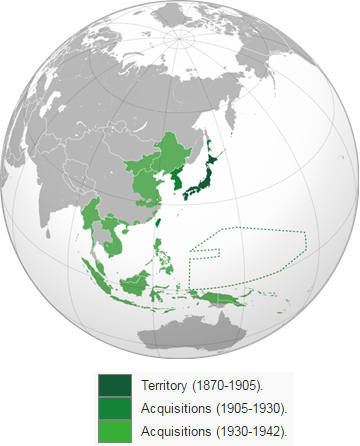
Following Japan’s loss in World War II, the countries of East and Southeast Asia were able to acquire independence. Some countries, like the Philippines and Burma, achieved independence through a peaceful turnover of control, while others such as Indonesia won independence only after a violent period of opposition. The end of World War II reshaped not only the political map of East and Southeast Asia but development in the region as well.
9.4 Political Conflicts and Changes East and Southeast Asia
The second half of the 20th century was a time of significant political change for East and Southeast Asia. The former colonies of Japan were able to break away from their colonial past and become independent, but as in many other parts of the world, that independence often coincided with political conflict.
For Japan, the end of World War II brought a period of Westernization and rapid economic growth. Westernization refers to the process of adopting Western, particularly European and American, culture and values. Japan adopted a new constitution and embraced democratic principles. It continued to industrialize and would become a global leader in electronics and automotive production. Today, Japan has the fourth largest GDP behind only the United States, the European Union, and China.
In other parts of East and Southeast Asia, the political changes to the region following WorldWar II tended toward communism, a social, political, and economic system that seeks communal ownership of the means of production. Communism is associated with Marxism, an analysis of social class and conflict based on the work of Karl Marx (1818-1883 CE). In a typical society, factories are owned by a wealthy few who then pay workers a lower wage to ensure that they make a profit. In a communist society, however, the goal of Marxism would be a classless society where everyone shares the ownership and thus receives equal profits.
Marxist ideas spread to China by the early 20th century and found particular support among Chinese intellectuals. The Communist Revolution in Russia inspired Marxists in China who founded a communist political party that would eventually be led by Mao Zedong. The communist party continued to gain traction in China and following a civil war, Mao Zedong established the communist People’s Republic of China in 1949. The previous Chinese government fled to the island of Taiwan, which is officially known as the Republic of China and claims control of the entire mainland. China, however, maintains that Taiwan is part of China.
After securing political control of China, Mao Zedong sought to transform China’s culture by reorienting it around the ideology of communism. One of the first steps in this transformation was the Great Leap Forward from 1958 to 1961 which sought to reshape China’s agrarian society into an industrial power. Unfortunately, the changes led to widespread famine and the deaths of tens of millions of Chinese as a direct result.
Following the failure of the Great Leap Forward, Mao aimed to eliminate any remaining traditional elements of Chinese culture or capitalist thinking through the Cultural Revolution. Millions were imprisoned, forcibly relocated, or tortured, and historical relics and cultural sites were destroyed. After Mao’s death, several leaders responsible for the abuses committed during the Cultural Revolution were arrested and China began a period of modernization and economic reform.
In the Korean peninsula, allied forces divided the former Japanese colony along the 38th parallel. Russia would control the northern portion, where it helped install a communist government and economic system. The United States occupied the southern portion, where it assisted a pro-Western government in its political and economic development. Tensions between the two territories led to the Korean War in the early 1950s. Technically, the two sides are still at war having never signed a peace agreement and simply agreeing to a cease-fire. Today, North Korea, officially the Democratic People’s Republic of Korea (DPRK), follows a Marxist model of development with state owned enterprises and agriculture. The government has been accused of numerous human rights violations and the people of North Korea are severely restricted in terms of their economic, political, and personal freedom. In South Korea, on the other hand, officially known as the Republic of Korea, a democratic government replaced a series of military dictatorships and the country is considered one of the most developed in the region according to the Human Development Index.
Communist ideals spread to Southeast Asia, as well, where Marxism influenced the governments of newly independent countries. In Vietnam, for example, a communist movement was begun by Ho Chi Minh to try to gain independence from France following the end of Japanese occupation in WorldWar II. The communist forces were able to defeat the French in a key battle in 1954 and established a government in the northern territory. The country was then divided into a communist north and anti-communist and majority Catholic south. This was a time of high tension between the United States and the Soviet Union, and the US feared that the entire region would eventually come under communist control, essentially creating a Western capitalist hemisphere and an Eastern communist hemisphere. The fear that the fall of one country to communism would lead to the fall of other surrounding countries to communism was known as domino theory, and was originally meant as an anecdote but became the basis for US foreign policy in the region (see Figure 9.9).

The United States aimed to support South Vietnam’s resistance to the communist north’s goal of unification and began sending military advisors to the region. Military combat units followed and bombing campaigns began in 1965. The terrain of Vietnam was quite different than the geography of other areas where the US had previously fought. Much of Southeast Asia was tropical rainforest, and was ill-suited for the types of tanks and heavy artillery that had been so successful in World War II. The Viet Cong, referring to the Vietnamese communists, engaged in guerrilla warfare, using the terrain to support small, mobile military units. To try to combat these tactics, the US military sprayed chemical defoliants and herbicides, like Agent Orange, over Vietnam’s forests. In the end, waning support for the Vietnam War led the US to withdraw and in 1975, Vietnam was unified under communist rule. Over 1 million Vietnamese and 58,000 Americans died in the fighting. Millions others were exposed to Agent Orange causing health problems and disabilities, and the chemical had devastating effects on Vietnam’s ecosystem where it has lingered in the soil.
During the same time period, a communist organization known as the Khmer Rouge, which is French for “Red Khmers,” came to power in Cambodia. Khmer refers to the dominant ethnic group in Cambodia. The Khmer Rouge opposed Westernization and US involvement in the newly independent country and believed in a return to an agrarian society. Pol Pot (1925-1998 CE), the leader of the Khmer Rouge, led a campaign to eliminate the country’s schools, hospitals, and other institutions and make the entire society work on collective farms. Urban cities would no longer be the economic and political focus, but rather wealth would be spread out around the countryside. Most of the country’s intellectuals, including teachers and even people with glasses who were simply perceived as academic, were killed. Large prison camps were set up to house those who were believed to be a threat to communism. Cambodians of other ethnicities or who practiced religion were also executed. In total, more than one million people were killed, often buried in mass graves known as the Killing Fields. Cambodia’s attempt to transform into an agrarian society ultimately led to widespread famine and starvation. In 1978, Vietnamese forces invaded Cambodia and defeated the Khmer Rouge, but human rights continue to be severely restricted in the country.
Much of East and Southeast Asia exhibits characteristics of a shatter belt, an area of political instability that is caught between the interests of competing states. Beginning in the colonial era and continuing today, Western involvement in this region has at times led to industrialization and economic growth and at other times economic depression and a drive to return to traditional values. Today, political instability continues to plague several countries in the region.
9.5 Patterns of Economic Development in East and Southeast Asia
Despite the political changes and conflicts that marked the 20th century, the 21st century has largely been marked by economic development across East and Southeast Asia. Economic geography is a branch of geography that explores the spatial aspect of economic development. Economic geographers don’t just ask “Where is economic development occurring?” but also “Why is economic development occurring in some areas and not others?” In East and Southeast Asia, economic growth has largely resulted from regional and global trade. However, development is not spread evenly across the region and economic inequalities still persist.
Global connections have been the principle driver of economic success in East and Southeast Asia. Much of the trade connections have emerged between the countries in this region and the larger Pacific Rim, referring to the countries that border the Pacific Ocean. Many of these countries are members of the Asia-Pacific Economic Cooperation (APEC) which promotes free trade across Asia and the Pacific. In Southeast Asia, the countries of the region formed the Association of Southeast Asian Nations, or ASEAN (see Figure 9.10). The organization aimed to promote political security, economic growth, and social development among member countries.

In China and Japan, histories of relative isolation gave way to an embrace of globalization and global trade. Although China’s government is communist, it has allowed more free-market oriented economics in areas known as Special Economic Zones, or SEZs. These SEZs are located in coastal China and have special incentives to attract foreign investment (see Figure 9.11). Other capitalist shifts have occurred in China even allowing for US supermarkets and restaurants to open locations in the country. These SEZs, as well as other special development areas in China, have functioned as growth poles, which are areas that have attracted economic development in the region. In 2010, China displaced the United States as the global leader in manufacturing.
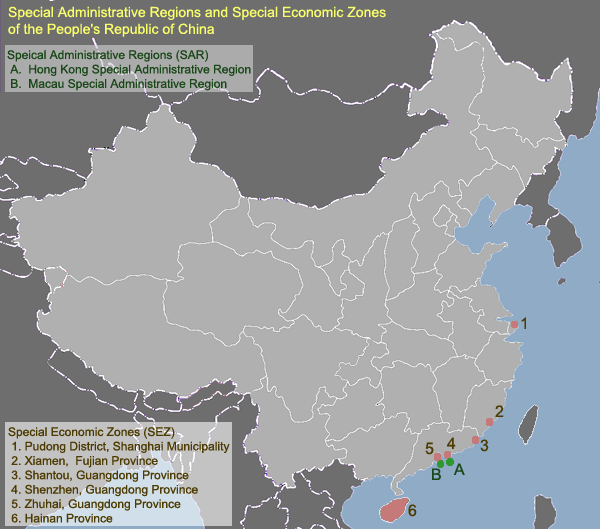
Broadly, foreign direct investment (also called FDI), the control of a business in one country by a company based in another country, has been a key driver of China’s economic success. In 2017, China was the second most attractive company for foreign investors, behind the United States, with over $136 billion in foreign direct investment flowing into the country according to the 2018 World Investment Report. China has done its own foreign direct investing as well, increasing outward flows of FDI from $5.5 billion in 2004 to over $125 billion in 2017, according to the same report. Hong Kong is the primary destination for Chinese foreign direct investment, but substantial sums also flow to countries in Africa as well as Australia, where China is the largest trading partner. Within Southeast Asia, China is now the top investor in Myanmar and has increased foreign direct investment in Singapore.
While China and Japan remain the largest economies in the region, other areas have experienced high rates of economic growth. The Four Asian Tigers, in particular, referring to Hong Kong, Singapore, South Korea, and Taiwan, experienced rapid industrialization and economic development led by export-driven economies, low taxes, and free trade. Some have also theorized that the Confucian work ethic present in these countries complemented the process of industrialization. Each country also developed a distinct specialty and maintains a competitive advantage in that area. South Korea, for example, is known for its manufacturing of information technology while Hong Kong is a leading financial center.
Much of the economic growth of the Asian Tigers as well as Japan has come from the export of value added goods. When countries export raw materials, their economic benefit is limited since those raw materials are often not inherently valuable. When these raw materials are made into something useful, however, value is added and the product can be sold for a higher profit. Lumber is quite cheap, for example. When the lumber is made into a dining table, it has a much higher value. Many companies located in these countries have become household names in electronics, computing, and the auto industry. China has traditionally exported relatively low value added goods, but in 2016, the Chinese government announced a shift to higher value added products like transportation technology and telecommunications.
Southeast Asia has benefitted from its key geographical position as the entrepôt, a French term meaning a commercial center of trade, for the rest of Asia. The Strait of Malacca in particular is the main shipping channel between the Pacific Ocean and the Indian Ocean and a key transportation gateway (see Figure 9.12). Around one quarter of all the world’s exported goods travels through the strait each year. Malaysia’s economic success as an entrepôt is exemplified by its Petronas Towers in Kuala Lumpur, which were the tallest buildings in the world from 1998 to 2004. Indonesia has the largest economy of Southeast Asia, exporting primarily to Japan, Singapore, the United States, and China. Singapore has the highest GDP per capita in the region, again owing to its key geographical position.
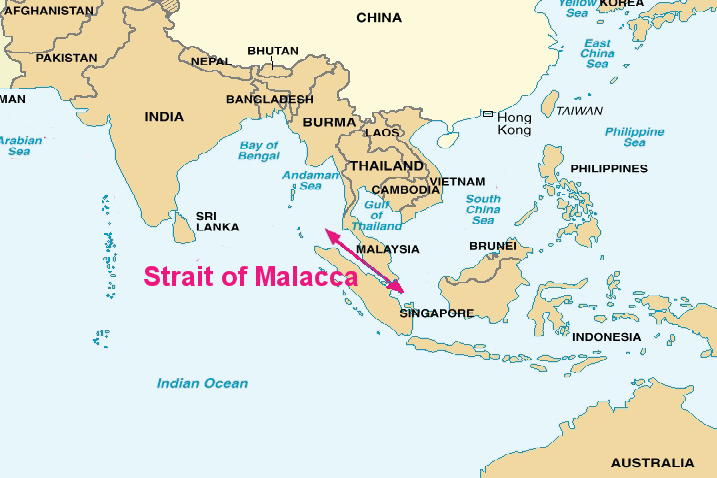
One lingering issue in many of these countries has been crony capitalism, the notion that the success of a business depends on its relationship to other businesses and the state. A politician might have an old friend in the manufacturing industry, for example, and give the friend a government contract with beneficial terms. In 1997, a financial crisis that started in Thailand spread throughout the Southeast Asia region and to South Korea was, in part, blamed on the business dealings of corrupt politicians. Several countries in this region rank high on an index of corruption perception, as shown in Figure 9.13, and some have expressed concern that the communist countries of this region will continue to embrace capitalism when it is politically beneficial rather than as part of a broader and more transparent economic system.
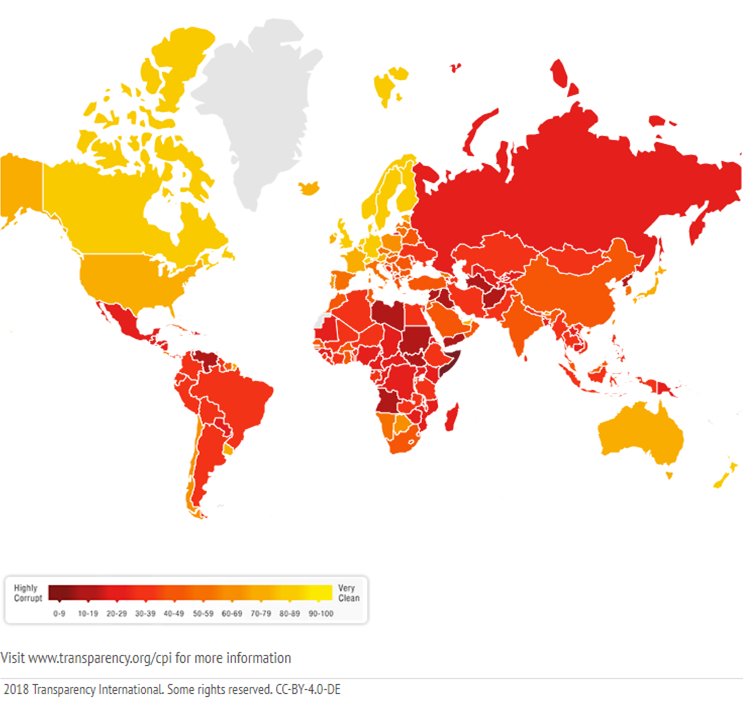
Economic development is not spread evenly throughout the region. By most estimates, North Korea remains the poorest country in the region with an estimated GDP per capita of just $1,300 in 2016. Mainland Southeast Asia, with the exception of Thailand, remains relatively poor. Cambodia, Laos, Myanmar, and Vietnam all have GDP per capitas of less than $8,000 as of 2018 and remain far less well off than their more developed neighbors in the region.
Where economic growth has occurred, it is often confined to an urban area which can drive up population densities as people move to the city in search of work. In Indonesia, the island of Java is very densely populated while other surrounding islands are relatively sparse. The Dutch colonizers and later the Indonesian government, in a stated effort to reduce poverty and overcrowding, created a policy of transmigration seeking to relocate people to the less densely populated islands. This program has been controversial, however, and the indigenous people who inhabit the surrounding islands see the program as a threat to their way of life.
In some cases, uneven distribution of economic development has led to both interregional and intraregional migration as people move in search of economic advancement. China in particular has seen a significant amount of rural to urban migration. Around 11 percent of the entire country’s population migrated from rural to urban areas in 2009 and most of them are young adults. Many of China’s migrants are part of a floating population, which refers to members of a population who reside in an area for a period of time but do not live there permanently. Around 50 million Chinese reside overseas, mostly in Southeast Asia. Thailand has the largest population of overseas Chinese, and Chinese also represent the majority ethnic group in Singapore. Long before colonization, East and Southeast Asia was a realm of global economic influence, from the Chinese empire to the trade routes of Southeast Asia. As some countries of the realm have moved toward political stability and economic growth, others have remained in a state of political and economic turmoil. Tourism could bring some of these countries an economic boost, but the prospect of tourism in countries with government instability is limited. Still, although countries like Laos, Myanmar, and Cambodia currently have some of the world’s smallest economies, they are some of the fastest growing in the world and improvements in agricultural and natural resource development combined with a stable political infrastructure could expand the economic strength of the region.
an area of high tectonic activity along the Pacific Ocean basin
an area where one tectonic plate is subducting, or moving below, another plate
a high sea wave resulting from the displacement of water
also known as the New Stone Age, a time of key developments in early human technology, such as farming, the domestication of plants and animals, and the use of pottery
the process of adopting Western, particularly European and American, culture and values
a social, political, and economic system that seeks communal ownership of the means of production
an analysis of social class and conflict based on the work of Karl Marx
a campaign begun in 1958 by the Communist Party of China that sought to reshape China’s agrarian society into an industrial power
refers to the fear that the fall of one country to communism would lead to the fall of other surrounding countries to communism
a communist organization in Cambodia that opposed Westernization and believed in a return to an agrarian society
an area of political instability that is caught between the interests of competing states
refers to the countries that border the Pacific Ocean
an international organization that seeks to promote political security, economic growth, and social development among member countries in Southeast Asia, also known as ASEAN
a special region in China where more free-market oriented economics are allowed, also known as SEZ
a cluster within a region that has attracted economic development
the control of a business in one country by a company based in another country, also known as FDI
refers to Hong Kong, Singapore, South Korea, and Taiwan which have experienced rapid industrialization and economic development led by export-driven economies, low taxes, and free trade, sometimes also called the Four Asian Tigers
a raw material that has been changed in a way that enhances its value
a French term meaning a commercial center of trade
members of a population who reside in an area for a period of time but do not live there permanently
